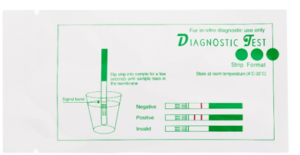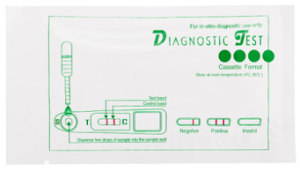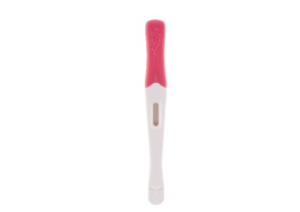
discover more | articles
discover more
articles
browse categories:
pregnancy
What is a home pregnancy tests?
A home pregnancy test is a self-diagnostic tool that allows women to quickly and easily determine whether they are pregnant. These devices are designed to indicate if a woman’s urine contains a hormone called human chorionic gonadotropin (hCG). A technique known as an immunoassay, which involves a complex reaction between the hormone and various protein antibodies, is used to measure hCG.
The tests are easy to use: A urine sample is combined with the antibodies, and the test is timed. A colour change indicates a positive or negative result.
What is the difference between strip, device, and midstream tests?
There are three types of home pregnancy tests available on the market: strip, device (also called a cassette), and midstream tests. The test procedure varies for each of these formats. Deciding which one to choose depends on user preference.
| FORMAT: STRIP HCG TEST | |
 |
 |
| FORMAT: DEVICE / CASSETTE HCG TEST | |
 |
 |
|
FORMAT: MIDSTREAM HCG TEST |
|
 |
Note that the plastic housing surrounding the actual test may differ in design and colour, depending on the manufacturer.
When is the best time to take a home pregnancy test?
The hCG hormone is produced right after a fertilised egg attaches to the wall of a woman’s uterus. This usually (but not always) happens about six days after fertilisation. In the case of pregnancy, levels of hCG continue to rise rapidly, doubling every two to three days. Therefore, waiting at least a week after a missed period to take a pregnancy test may yield the most accurate result.
Results may also be more accurate if you administer the test first thing in the morning when your urine is more concentrated. The hCG levels are at their maximum between weeks 8 to 11 of pregnancy and drop lower between weeks 12 and 16.
How accurate are home pregnancy tests?
This depends on:
- How closely the instructions are followed
- When a woman ovulates in her cycle and how soon implantation occurs
- How soon after conception a test is taken
- The sensitivity of the pregnancy test
- Expiration date
- Exposure to sunlight or extreme temperatures
Regardless of the brand used or result obtained, most manufacturers recommend repeating the process a few days later to confirm the test result, since levels of hCG following conception are so low. If a pregnancy test yields a positive result, a woman should consult a doctor for a blood test to confirm the pregnancy and to talk about the next steps.
How sensitive are home pregnancy tests?
Many consumers believe that all home pregnancy tests on the market are basically the same, but this is not the case. Some of these tests are much more sensitive to the pregnancy hormone than others. The more sensitive a test is to this hormone, the earlier a woman can obtain a positive result if she is pregnant. For example, a home pregnancy test that is said to read 25mlU/ml of hCG is much more sensitive and will give an earlier, accurate result than those that read 50mlU/ml or 100mlU/ml of the pregnancy hormone.
My pregnancy test shows no lines. What does that mean?
If no lines appear on the strip after testing (which is a rarity), disregard the test – it is either defective or was sampled incorrectly. Incorrect sampling can happen if the test was not held properly in the urine stream or if a device (cassette) was over-sampled.
My pregnancy test shows a faint line. Does that mean I am not pregnant?
It is normal for a faint second line to appear on a test during early pregnancy when the hCG levels are still quite low. Similarly, a darker line might appear if the pregnancy has progressed. When a faint line is present, it is best to take another home pregnancy test after a few days.
Can something interfere with or affect test results?
Yes. If a woman is taking medicine with the pregnancy hormone hCG as an active ingredient, she may get a false-positive test result. (A false positive is when a test indicates that someone is pregnant when she is not.)
An example of medication containing hCG is certain infertility treatments. If you are taking medicine to help you get pregnant, the best option to screen for pregnancy would be to see your doctor for a blood test.
However, most medicines should not affect the results of a home pregnancy test. This includes over-the-counter and prescription medication (e.g. birth control pills or antibiotics). Also, alcohol and illegal drugs do not affect pregnancy test results. However, certain medical conditions can.
The test results indicate I am not pregnant. Could I still be pregnant?
Yes, it is possible to be pregnant and to have a pregnancy test show that you are not. (This is called a false negative.)
The accuracy of home pregnancy test results varies from woman to woman because:
- Each woman ovulates at a different time in her menstrual cycle.
- The fertilised egg can implant in a woman's uterus at different times.
- Sometimes women get false-negative results when they test too early in the pregnancy.
- Problems with the pregnancy can affect the amount of hCG in the urine.
If a test indicates you are not pregnant, take another pregnancy test after a few days. If you are pregnant, your hCG levels should double every 48 hours. If you suspect that you are pregnant, but more tests indicate you are not, it is best to consult your doctor.
How do I know that the test is working?
Pregnancy tests are designed with a built-in quality-control check – they have a control area that is designed to show if the test is working properly. This window will reveal a coloured line if the test is functioning. To limit the potential for false or misleading readings, the test is wrapped in a foil pouch. It should not be removed from the pouch for more than five minutes before the test is conducted, or a false result may be obtained. If the quality control line appears, the test is working properly.
I spotted a colour change 20 minutes after taking the test. What does this mean?
After the test is completed, the coloured lines of a pregnancy test result will last at least 24 hours. A positive result will not change several days after the test was completed. However, a reddish background might appear several hours after the test was performed.
A negative result should not be read in the test window more than five minutes after the test was performed. Any result appearing after five minutes should be disregarded as it could be a reaction and/or evaporation lines. Some negative tests might thus appear weakly positive. Therefore, we advise that tests are read exactly within the time frame as per the instruction leaflet.
What types of pregnancy tests do doctors and clinics use?
Medical practitioners use strip or device pregnancy tests, similar to the tests that you can buy from the pharmacy, as a screening test to identify the possibility of a pregnancy. The pregnancy is then confirmed by a blood test, done in a laboratory. Should the screening test be negative, but the doctor still suspects pregnancy, a blood test will be done.
ovulation
Struggling to fall pregnant? Improve your chances by using thyme home ovulation tests:
For women, finding the most fertile time of the month can be a challenge. A woman’s ovary releases one egg per menstrual cycle during a process called ovulation. After it is released, an egg will remain in a woman’s fallopian tube for several hours to be fertilised.
The Thyme Home Ovulation Test signals when a woman is most likely to release an egg that could be fertilised by sperm. If used correctly, this ovulation test can be more than 90 per cent effective.
The test works by detecting the luteinising hormone (LH). At the beginning of the menstrual cycle, the body produces what is called follicle-stimulating hormone (FSH). FSH facilitates the formation of the follicle on one of the ovaries. Follicles convert and nurture the ovum. When the follicle has matured sufficiently, a surge of LH causes it to rupture, and the ovum is released near the fallopian tube – a woman is now ovulating. Increased amounts of LH facilitate ovulation, and this is detected by the ovulation test through anti-LH antibodies contained in a sensitive test membrane. A positive result on the ovulation test means that a woman will most likely be fertile over the next three days with a peak in fertility at 36 hours following the LH surge.
The test resembles basic sticklike pregnancy urine tests and also produces results within five minutes. Since LH “surges” (suddenly increases) in a woman’s body one to two days before an egg is released, these tests provide couples with a time frame during which to have intercourse to increase the chance of conceiving a baby.
What is a home ovulation test? What is a home ovulation test?
An ovulation home test is used to determine the time in a woman’s menstrual cycle when falling pregnant is most likely. The test detects a rise in luteinising hormone (LH) in the urine. A rise in this hormone signals that the ovary is about to release the egg and pregnancy is most likely to occur.
When is the best time to take the test? When is the best time to take the test?
The length of a menstrual cycle is the duration from the first menstrual bleeding day to the day before the next bleeding begins, with ovulation occurring roughly in the middle of this cycle. Determine the length of your menstrual cycle before testing for ovulation. If your cycle is shorter than 21 days or longer than 38 days, consult a physician. If you do not know your cycle length, you may begin the test 11 days after your first period, since the average cycle length is 28 days. Perform one test each day over a five-day period or until the LH surge has been detected.
Unlike with pregnancy tests, where the use of the first urine of the morning is recommended, a urine sample taken at any other time during the day should best be used for ovulation testing. For optimal results, collect urine at the same time each day.
How accurate are home ovulation tests?
When used correctly, ovulation tests are approximately 99 per cent accurate in detecting the LH surge that precedes ovulation. However, these tests cannot confirm whether ovulation will actually occur a day or two later. Some women may have a surge in the LH hormone without an egg being released.
My ovulation test shows a faint line. Does that mean I am not ovulating?
If the test line shows up darker than the control line, you are about to ovulate. There are always low levels of LH in your body, so if the test line appears lighter than the control line, you are not ovulating yet. Remember, ovulation tends to occur about halfway through the menstrual cycle.
My ovulation test shows no test line. What does that mean?
When a surge in LH is not detected (indicating that ovulation is not occurring), two pink lines may appear in the result window, but the test line will be lighter than the reference line.
Alternatively, a reference line and no visible test line may appear. Continue with daily testing until ovulation is detected (see above).
Can something interfere with or affect test results?
If the first urine of the morning is used for an ovulation test on the first day of the LH surge, it may not be detected. Limit fluid intake for about two hours before taking the test as heavy intake of fluids will dilute the hormone in your urine.
Some hormonal medications and medical conditions can interfere with test results.
My ovulation test says I am not ovulating. Could I still be ovulating?
The peak time of LH is short, and you may have missed it, resulting in a negative test result. That is why tests should ideally be done twice a day, starting 17 days before the expected period or three days before the potential ovulation. Continue testing until the result is positive.
How do I know that the ovulation test is working?
If the control line (C) appears, it indicates that the test is working.
I spotted a colour change 20 minutes after taking the ovulation test. What does this mean?
Results must be read five minutes after the test was completed and not thereafter. Though the indication of a positive result should not change for several days, a negative result may change to a false positive within minutes after testing, yielding an inaccurate reading. Therefore, the results should be read five minutes after completing the test, and thereafter the test device should be discarded to avoid confusion.
male fertility
Low sperm count is a leading cause of male infertility
Planning to get pregnant? Is it taking longer than anticipated?
Seven million couples who try to have a baby this year will face fertility issues. Male infertility is the cause of 50 per cent of infertility problems. Yet, 80 per cent of men in infertile couples will not receive a fertility evaluation.
An important first step in planning for a pregnancy or determining the cause of a couple’s infertility issues is to test the man’s sperm count. However, a trip to a fertility clinic for a semen analysis is not for everyone. These tests can be expensive, inconvenient and are often experienced as embarrassing.
Enter SpermCheck® Fertility: a unique, inexpensive home sperm-test kit that can help you save time, money and frustration, and avoid unnecessary and expensive testing of the female partner in the couple.
For couples planning for pregnancy or experiencing issues becoming pregnant, SpermCheck® Fertility is the one and only over-the-counter home test that indicates in just 10 minutes whether a man has normal or low sperm count – from the privacy and convenience of his own home.
SpermCheck® Fertility is a simple, FDA-cleared male fertility product that provides quick and reliable sperm count results. The test is designed to be used as the first step in male fertility testing and can help inform a man whether more comprehensive, clinical fertility evaluation may be needed.
How to read the spermcheck fertility test:
The SpermCheck® Fertility Test is easy to use, and the results are available in 10 minutes. Detailed instructions are included with each test kit. To ensure accurate test results, please read these test instructions thoroughly before performing the test.
A Positive Test Result
If you see a test line (at the T position in the results window), your sperm count is at least 20 million per millilitre. About 90 per cent of fertile men have sperm counts above 20 million per millilitre, so a positive test result indicates that your sperm count is at the level needed for conception.
A Negative Test Result
If you do not see a test line (at the T position in the results window), your sperm count is less than 20 million per millilitre. On average, 10 per cent of fertile men have sperm counts below the 20 million per millilitre mark, which means a negative test result is not definitive. Please consult a doctor about possible treatments for sub-fertility, especially if you and your partner have been unsuccessfully trying to start a family. There are also simple lifestyle changes that may have a positive impact on your sperm count.
An Invalid Test Result
If you do not see a control line (at the C position in the results window), your test did not run correctly, and the results are not valid. You should test again with a new sample and a new SpermCheck® Fertility kit. Wait at least 48 hours, but not more than seven days, after your last ejaculation to retest.

